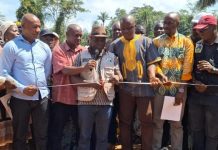Deji Adegoke
|
Dr. Rotimi Adeniyi-Akintola
|
Chiamaka Isigwe
Africa-Press – Liberia. The key to addressing Africa’s food and energy security requires robust infrastructure investments, strategic partnerships, regulatory measures and integrated solutions
Although food and energy insecurity continue to pose significant barriers to inclusive development across Africa, a new era is emerging: one that is defined by integrated approaches, large-scale infrastructure investment and a strategic focus on leveraging the continent’s natural and human resources.
In this article, we explore the growing convergence of food and energy security in Africa. We examine the structural challenges, the investment landscape and the increasing role of industrial-scale fertilizer production in creating a more resilient future, focusing on three major projects: the AMUFERT fertilizer plant (Angola), the Blackrose methanol plant (Nigeria) and the Indorama fertilizer plant expansion (Nigeria). Together, these developments signal a broader transformation in how Africa is securing the resources and tools needed to feed its people and power its growth.
The current landscape
Africa is richly endowed with natural resources. It has the majority of the world’s uncultivated arable land and holds substantial reserves of oil & gas. Despite this, more than one in five Africans, nearly 300 million people, faced food insecurity in 2023, according to the Food and Agriculture Organization of the United Nations (FAO). Moreover, the International Energy Agency reports that about 545 million people in sub-Saharan Africa are projected to remain without access to reliable electricity in 2030.
These dual challenges are not independent but are rather tightly connected, each amplifying the other. Agricultural production remains constrained by low fertilizer usage, erratic power supplies and insufficient investment in agro-processing infrastructure. At the same time, much of the continent’s natural gas is untapped or flared due to underdeveloped midstream and downstream markets. Now, for governments and investors, addressing these challenges in tandem is a clear priority.

Fertilizer: The strategic link between energy and agriculture
Fertilizer lies at the heart of Africa’s agricultural productivity. Its availability and affordability directly influence yields, food prices and trade balances. Yet, fertilizer consumption in sub-Saharan Africa remains a fraction of the global average. This is largely due to the high import dependence, foreign exchange constraints and underdeveloped distribution networks.
Domestic fertilizer production is increasingly being recognized as a strategic priority and a national security imperative. It reduces exposure to global supply shocks, supports local farming communities and provides a platform for industrial diversification. Most fertilizers, particularly urea-based products, are manufactured using natural gas as a feedstock. This relationship between fertilizer production and gas infrastructure offers an attractive opportunity to monetize domestic energy reserves, creates the potential for countries to reduce gas flaring, enhances energy efficiency, and generates value across both the agricultural and energy sectors.
Spotlighting fertilizer production plant projects
Here, we explore how three industrial-scale fertilizer production plants are strengthening Africa’s food and energy security.
AMUFERT fertilizer plant
The proposed AMUFERT fertilizer plant in Africa is one of the most significant fertilizer projects currently in development. Located in Soyo (northern Angola), the project aims to produce more than one million tonnes of urea and ammonia fertilizer annually. A group of lenders, led by the African Export-Import Bank, are expected to provide approximately US$1.4 billion of financing for the construction and delivery of the project, which is being developed by the Opaia Group, the Sovereign Wealth Fund of Angola and Sonangol.
The project is the cornerstone of Angola’s broader strategy to transition from a crude oil-based economy to one driven by diversified, value-added sectors. By leveraging Angola’s domestic natural gas for fertilizer production, AMUFERT is expected to reduce fertilizer imports, increase crop productivity and boost regional trade capacity. Once operational, AMUFERT is poised to supply not only Angola’s domestic needs but also significantly contribute to fertilizer access across the region. Its impact is projected to be wide-ranging, with benefits including food security, job creation and emissions reduction by eliminating gas flaring.
Indorama fertilizer plant
Nigeria is increasingly positioning itself as a regional hub for fertilizer production. A key part of this effort is Port Harcourt–based Indorama Eleme Fertilizer and Chemicals Limited, which operates two large-scale fertilizer plants and is expanding with a third nitrogenous urea fertilizer plant that will increase the total annual capacity to approximately 4.2 million metric tonnes. A syndicate, led by the International Finance Corporation, provided US$1.25 billion in financing for the expansion in early 2024.
The Indorama project reflects a broader trend of gas-to-fertilizer industrialization. It uses domestic natural gas, including previously flared volumes, to produce high-grade urea fertilizer for both local and export markets. With integrated logistics and port access, Indorama can reach markets throughout Africa and beyond, thereby improving regional and global access to agricultural resources.
This development also illustrates the role of blended finance and multilateral support in unlocking complex projects, highlighting how legal innovation, regulatory stability and the project’s financial viability can come together to attract long-term private and institutional capital that is essential for infrastructure.
Blackrose Methanol Plant
The Blackrose methanol project in Akwa Ibom, Nigeria is another important example of how gas monetization can support the broader agricultural and industrial value chain. It is primed to be Africa’s largest gas-to-methanol plant, with the aim of significantly reducing CO2 emissions by offsetting the flaring of natural gas and turning it into a valuable chemical for production of fertilizers, solvents, paints, plastics and car parts. The project targets producing an initial 1.8 million tonnes per annum of methanol, diversifying the local economy and generating more than 18,000 jobs. This project is led by Blackrose, a project development and investment firm, and is supported by the Africa Finance Corporation’s project development facility.
This project reflects an evolving shift toward industrial projects that bridge energy access, environmental performance and agricultural productivity. It also demonstrates the depth and complexity of Africa’s project finance ecosystem, with legal structuring and risk mitigation central to its development.
The impact of the midstream infrastructure development
Central to overcoming food and energy insecurity in Africa is the development of midstream infrastructure to facilitate the transportation of natural gas across the continent. The underdevelopment of midstream infrastructure creates a bottleneck for investment in natural gas and fertilizer production, which is vital for generating power and industrial processes.
Investment in Africa’s midstream sector has become a key focus for governments and regional stakeholders. Two flagship projects, the West African Gas Pipeline (WAGP) and the Africa Atlantic Gas Pipeline (AAGP), exemplify the transformative impact of midstream infrastructure development on Africa’s food and energy security.
West African Gas Pipeline project
The West African Gas Pipeline is a pioneering initiative for securing energy throughout Africa. Spanning approximately 678 kilometers from the Itoki terminal in Lagos, Nigeria to Takoradi, Ghana and passing through Benin and Togo, the WAGP delivers natural gas directly to neighboring countries. With an initial capacity of 170 million standard cubic feet per day (MMscfd) and a peak capacity of 460 MMscfd, the WAGP has the capacity to supply affordable, reliable natural gas-to-power plants along its route, thereby enabling a shift from expensive imported fuels to cleaner, cheaper gas. This transition reduces electricity generation costs, mitigates foreign exchange pressures by substituting imported fuels with regional gas, and improves the reliability of the power supply, which is essential for socio-economic development.
Africa Atlantic Gas Pipeline
The Africa Atlantic Gas Pipeline is another significant project that illustrates the vision of regional energy integration across West Africa and into North Africa. The pipeline, which is a joint initiative by the Moroccan Office of Hydrocarbons and Mines and the Nigerian National Petroleum Company Limited, is expected to originate from Brass Island, Nigeria, passing through 13 West African countries before ending in Morocco. It costs approximately US$25 billion and is expected to be completed by 2046.
The project is a bold move to harness Africa’s vast natural gas resources for widespread energy generation and industrialization. It is supported by major financial institutions such as the Islamic Development Bank, the OPEC Fund for International Development and the European Investment Bank. It is set to transport up to 30 billion cubic meters of natural gas annually and improve energy security for nearly 400 million people.
Key insights: Investing in Africa’s resilience
Africa’s future prosperity depends on its ability to feed its people and power its economies. Fertilizer and natural gas production sits at the nexus of these objectives. Projects such as AMUFERT, Indorama, Blackrose, the West African Gas Pipeline and the Africa Atlantic Gas Pipeline offer tangible examples of how energy assets can be transformed into agricultural productivity, power generation and industrial development. They also underscore the importance of strategic legal support in navigating regulatory complexity, securing financing and ensuring long-term sustainability.
As governments, financiers and operators look to expand Africa’s food and energy systems, the need for integrated planning, robust partnerships and transparent governance will only grow.
source:whitecase
For More News And Analysis About Liberia Follow Africa-Press






